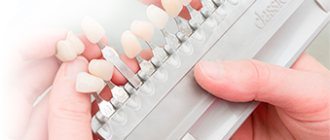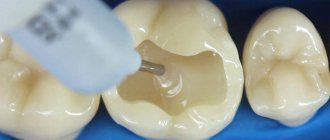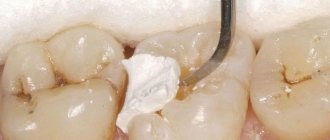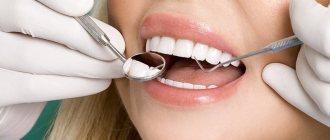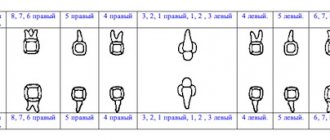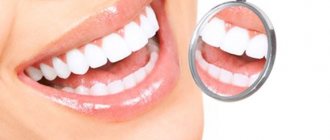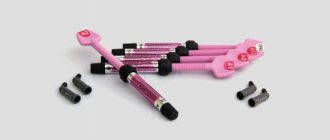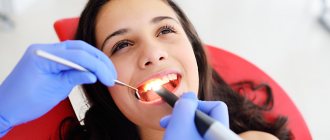Thanks to modern technology, visiting the dentist has become a simple and painless procedure that allows you to monitor your oral health and identify and eliminate various problems. The best material used for filling teeth today is Estelite - a composition that has no analogues in terms of durability, ease of use and reliability.
Characteristics and properties
Estelite (Estelite Sigma Quick) is a development from Japan, created and used for dental filling. High indicators of light curing, radiopacity and polymerization speed guarantee the appropriate quality of the finished fillings.
The composition is based on silicon-zirconium mass, the total share of which exceeds 80%. Its use is the key to minimal shrinkage of the processed material, resistance to wear and abrasion. The color range, numbering two dozen shades, and the long-term preservation of aesthetic properties maintained by polishing allow Estelite to be effectively used in various medical situations.
General overview
The universal light-curing composite material Estelite is produced by the Japanese company Tokuyama Dental.
The radiopaque composite includes a submicron filler that allows you to restore the integrity of the anterior and lateral teeth affected by caries.
The drug is ideal for use in carious cavities of all classes, and is a set of universal elements with enhanced radiopacity and light-curing characteristics.
The high aesthetic factor in tandem with the increased speed of the polymerization process has increased the popularity of the material around the world . Today it ranks among the best dental products among existing composite materials.
Features of application
During use of the composition, the monomer is filled to 100%, forming a solid structure. Simultaneous filling of dentin fragments promotes uniform demineralization and penetration of adhesive elements inside. The composition is characterized by stable adhesive strength indicators, which are not affected by the quality of the working area.
To determine the filling boundary, dentists rely on the colored pigment, which subsequently disappears from the surface of the tooth. After polymerization, the composition reduces the permeability and sensitivity of the enamel.
Rules for tooth preparation
The effectiveness of therapy directly depends on the quality of tooth preparation for restoration. Like any therapeutic measures, the preparatory process is carried out according to an established algorithm, which is followed by the doctor in strict order:
- The tooth being restored is cleaned using a paste that does not contain fluoride compounds. The treated surface is thoroughly washed with water.
- The next step is choosing a suitable shade. The Estelite shade scale is replete with variety, however, despite this, there are factors that require special attention.
One of them is white color saturation. If there is any doubt about the choice of tone, the specialist uses the lightest shade. This solution is guaranteed to give a good result.Wet organs of the jaw row have a dark tint, so it is more advisable to evaluate the color of the protective layer of the tooth after complete removal of moisture. Restoration of units is carried out no earlier than 20 days after the bleaching procedure, if it was carried out.
- The tooth being restored needs to be isolated while the cavity is being filled with Estelite. For these purposes, it is best to use a rubber dam, rubber dam or latex curtain.
- Tooth turning. The dentist prepares the element of the dentition in such a way that there is space left for the future structure.
When treating the anterior element of the jaw row, along the edge of the enamel, the specialist performs bevels. In the case of a lateral unit, the edge lines are smoothed. This will improve aesthetic perception. - If the working area is located near the pulp , the doctor will apply a glass ionomer pad, which will protect tissues with a large number of nerve endings from damage and particles of the material used.
The gasket is formed from a paste with calcium hydroxide. Experts do not recommend using other products as protection, as they may disrupt the curing process. - Treatment of the organ with an adhesive system. The best result can be achieved if you use one-component products with filling material.
If they are not available, it is important to select a good quality light-curing system that can provide the necessary adhesion effect.
Indications for use, preparation and application
The universal characteristics of high-quality fillings formed using Estelite provide a wide range of possibilities for use. Possible clinical indications include:
- restoration of the frontal jaw area;
- correction of surface defects on enamel;
- direct restoration of the base layer;
- restoration of installed prostheses;
- elimination of gap-like spaces and diastemas;
- therapeutic prevention of caries.
The presence of methacrylic-based monomers in the composition of the drug is a key factor limiting the possibility of use for people suffering from allergic reactions to compounds of this group. Intolerance to this element should be clarified before starting therapy.
When preparing the oral cavity for medical restoration, a number of procedures are performed in the required sequence:
- Cleaning the enamel layer using a special mass that does not contain fluoride;
- Selecting a color tone using a shade scale;
- Isolation of the dentition element using latex plates;
- Standard preparation followed by rinsing with water;
- Pulp protection with an artificial glass ionomer barrier;
- Application of the composition and formation of the restoration contour.
During the restoration process using Estelite, it is recommended to strictly follow the instructions for use. The composition is applied either directly into the working cavity of the tooth, or squeezed out of a syringe onto a separate tablet to give the desired consistency. The introduction into the hole is carried out layer by layer, without exceeding the depth, and each layer must undergo a polymerization procedure, the duration of which is determined by the manufacturer’s special table. It is important to note that mixing the composition with other restorative pastes leads to the formation of voids and defects in the final polymerization.
At the final stage, the finished filling is processed and polished using a fine-grained drill. To improve the aesthetic perception and appearance, fractional grinding technology is used at minimum speed, without the use of water. Proximal elements should be treated with vinyl or metal strips. The finished shape can be further polished using a special rubber nozzle or other device.
Indications and contraindications
The product is versatile, so it can be used for various indications, namely:
- direct restorations of anterior teeth, for example, small carious lesions in the frontal area of the jaw row;
- elimination of minor defects on the surface of teeth, such as chips and cracks;
- for direct restorations as a base coat;
- for the treatment of dental units using the indirect restoration method;
- for leveling and eliminating defects that appeared on the surface of previous restorations;
- restoration of artificial organs of the jaw row;
- filling gaps (disproportionately large gaps between fragments of a row);
- when forming composite veneers;
- for therapeutic purposes aimed at eliminating carious manifestations of any type.
Since the composition of the material includes methacrylic monomers, there is a possibility of individual intolerance to this component by the patient’s body, which will be a contraindication to the use of Estelite.
This also includes a tendency to allergic reactions to methacrylics and products with similar characteristics.
How effective is the Filtek filling material, judging by the reviews of specialists.
In this publication we will talk about the properties of glass ionomer cement for filling teeth.
Here https://zubovv.ru/lechenie/zubyi/plombyi/rasplombirovanii-kornevyih-kanalov.html read about the indications and contraindications for root canal filling.
Reviews
Nanocomposite Estelite is a high-quality and reliable dental product that greatly simplifies the work of a specialist. It is difficult to find an identical composition among filling materials.
If you have already had to restore teeth using Estelite, and after reading the article you would like to share your feedback about the advantages or disadvantages of the presented filling, leave your review in the comments below.
If you find an error, please select a piece of text and press Ctrl+Enter.
Tags filling fillings
Did you like the article? stay tuned
No comments yet
Estelite Sigma Quick shades
A1, A2, A3, A3.5, A4, A5, B1, B2, B3, B4, C1, C2, C3, OA1, OA2, OA3, OPA2, BW (Bleach White), WE (White Enamel , white enamel) and CE (Clear Enamel/Incisal, transparent enamel/incisal shade).
Opalescent shades (OA1, OA2, OA3) have adequate degree of opacity necessary to block the darkness of the oral cavity (restoration of class III and IV cavities)
Opalescent shades can also be used as dentin shades for layer-by-layer multi-shade restorations. The shades OA1, OA2 and BW are well suited for the restoration of primary teeth. However, they are not intended for use as camouflage agents for metal teeth or highly discolored teeth such as tetracycline teeth.
OPA2 is intended for use as a camouflage agent for the treatment of minor stains, as well as for the restoration of opaque teeth (applied in a thin layer to the lingual wall of a Class III and IV cavity).
Release form and price
A Japanese company produces Estelite nanocomposite in syringes. One serving can be purchased for 1,800 - 2,500 rubles, depending on the main component of the product.
The standard set includes 9 syringes, the test set includes 6 injectors. Accordingly, their price will be on average 13,000 and 18,500 rubles.
Precautionary measures
The use of any dental material requires compliance with safety measures. The Estelite filling is no exception to these rules.
The list is as follows:
- Professionalism is required. Only professional dentists who have a license to practice can use the material to fill cavities.
- Check authenticity. It is prohibited to use filling material if there is a suspicion of its authenticity and in the case when a doctor comes into contact with a product with damaged packaging.
- You need to be sure that you are not allergic. If allergic reactions to the drug occur, you must immediately stop using it.
- At all stages of working with the material, the physician must wear gloves. They will act as protection against allergic reactions to methacrylic pressure gauges.
It is important to know that most of these substances have the ability to penetrate the latex protective layer, so after filling it is important to thoroughly wash your hands under running water. - Direct contact of the product with the skin is unacceptable. If the material comes into contact with the skin or eyes, the affected area should be immediately rinsed with water and an appointment with a specialized doctor should be made.
- Caution in use. To avoid harm to health, inhalation of material vapors and ingestion of its particles is contraindicated.
- Immediately after filling, the patient should thoroughly rinse the mouth with plenty of clean water.
- Processing of tools . The tools used for mixing and applying the material are treated with an alcohol solution.
- At all stages of working with the material, specialists must wear safety glasses in front of their eyes.
